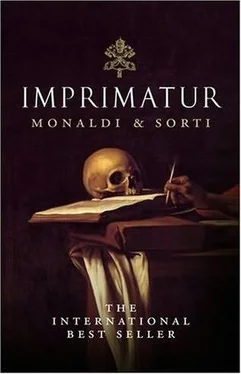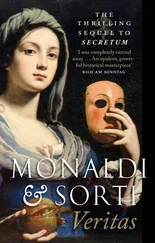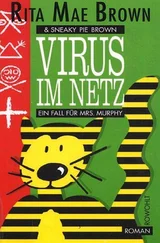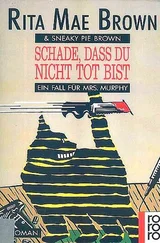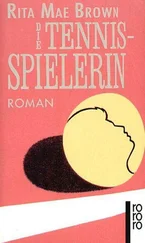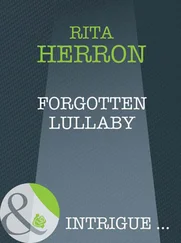Rita Monaldi - Imprimatur
Здесь есть возможность читать онлайн «Rita Monaldi - Imprimatur» весь текст электронной книги совершенно бесплатно (целиком полную версию без сокращений). В некоторых случаях можно слушать аудио, скачать через торрент в формате fb2 и присутствует краткое содержание. Жанр: Исторический детектив, на английском языке. Описание произведения, (предисловие) а так же отзывы посетителей доступны на портале библиотеки ЛибКат.
- Название:Imprimatur
- Автор:
- Жанр:
- Год:неизвестен
- ISBN:нет данных
- Рейтинг книги:5 / 5. Голосов: 1
-
Избранное:Добавить в избранное
- Отзывы:
-
Ваша оценка:
- 100
- 1
- 2
- 3
- 4
- 5
Imprimatur: краткое содержание, описание и аннотация
Предлагаем к чтению аннотацию, описание, краткое содержание или предисловие (зависит от того, что написал сам автор книги «Imprimatur»). Если вы не нашли необходимую информацию о книге — напишите в комментариях, мы постараемся отыскать её.
Imprimatur — читать онлайн бесплатно полную книгу (весь текст) целиком
Ниже представлен текст книги, разбитый по страницам. Система сохранения места последней прочитанной страницы, позволяет с удобством читать онлайн бесплатно книгу «Imprimatur», без необходимости каждый раз заново искать на чём Вы остановились. Поставьте закладку, и сможете в любой момент перейти на страницу, на которой закончили чтение.
Интервал:
Закладка:
Even the thoroughly mysterious tale of Fouquet's sequestration at Pinerol, as I have scrupulously verified, is authentic in every detail. The Sun King really did seem to be holding the Superintendent in prison for fear of what he knew; yet it has never been discovered what that might have been. The ambiguous Comte de Lauzun is also faithfully represented, he who for ten years was imprisoned at Pinerol, where he succeeded in communicating secretly (and quite inexplicably) with Fouquet and was released immediately after the Superintendent's demise.
The book did, then, contain a number of solid and well-documented references to historical reality.
"Now, what if it were all true?" I found myself thinking, as I turned the pages of this disturbing typescript.
At that juncture, I was unable to restrain myself from undertaking a number of other library searches, in the hope of uncovering some gross error which might demonstrate the falseness of my two friends' writings, and which might enable me to be free of the question. I must confess, I was afraid.
Alas, my suppressed fears were borne out. With unimaginable rapidity, bursting out from dictionaries, encyclopaedias and contemporary manuals, there emerged before my eyes-exactly as I had read in the typescript-descriptions of Rome, quarantine measures, all the theories concerning the plague, both in London and in Rome, Cristofano's remedies and the apprentice's menus; and similarly with Louis XIV, Maria Teresa, the Venetian mirror-makers, even down to Tiracorda's riddles and the plan of the underground galleries in the Holy City.
My head was in a whirl of thoughts about the divining rod, the interpretation of dreams, numerological and astrological doctrines, the saga of mamacoca (i.e. coca); and lastly, the battle for Vienna, including the secrets of French siege technique which the Turks had so mysteriously acquired, as well as the mystery of the strategic errors which led to the Infidels' ruinous defeat.
In the Casanatense Library in Rome, still incredulous before an original page from the Bible printed by Komarek, I gave myself up for lost: all that I had read proved stupefyingly authentic, down to the most insignificant details.
Albeit unwillingly, I found myself bound to continue. Instead of errors, I had found proven facts and circumstances. I was beginning to feel myself the victim of an astute trap, an evil system of wheels within wheels, a spider's web in which, the further one penetrates, the more one is ensnared.
I therefore decided to look into the theories of Kircher: I already knew quite a few things about his life and writings, but I had never heard either of the secretum pestis or indeed of the supposed secretum vitae capable of dispelling the plague, let alone of a rondeau in which its secret was encrypted. It is true that I had, like Padre Robleda, read Kircher's Magnes, sive de arte magnetica, in which the German Jesuit claims that music has therapeutic powers and even recommends the use of a melody composed by himself as an antidote for the bite of the tarantula. I also knew that in modern times Kircher had been labelled a charlatan: in his treatise on the plague, for example, he claimed that he had seen the bacilli of the disease under the microscope. Yet, the historians object, in Kircher's time, there did not exist sufficiently powerful magnifying lenses. So, was it all invented?
If that were the case, I would need to assemble all the necessary proofs. In the first place, I clarified my ideas about the disease known as the plague: this is the bubonic plague, caused by the bacillus Yersinia pestis which is transmitted by fleas to rats, and by the latter to man. It has nothing to do with the various animal plagues, or with the so-called pulmonary plague which from time to time strikes in the Third World.
The surprise came when I read that bubonic plague has not existed for centuries, nor does anyone know why.
I even found myself smiling when I read that in Europe (and even earlier in Italy) the plague practically disappeared at the turn of the seventeenth and eighteenth centuries, almost contemporaneously with the events at the Donzello. I was expecting that.
Many theories exist about its mysterious disappearance, yet none is definitive. Some see in this a consequence of more advanced measures of sanitation adopted by mankind; others, however, think that we must thank the arrival in Europe of Rattus norvegicus (the brown rat) which supplanted Rattus rattus (the black rat), which is host to Xenopsilla cheopis, the flea that acts as carrier of the plague bacillus. Others attribute the merit to new brick and tile buildings, replacing those built of timber and straw, or to the removal of domestic granaries, which drove rats from housing. Yet others insist upon the role played by pseudo-tuberculosis, a benign illness which has the effect of giving immunity to bubonic plague.
From academic discussions, however, only one thing emerges with certainty: between the seventeenth and eighteenth centuries, Europe was mysteriously freed of its most ancient scourge, just as Kircher had promised to bring this about by applying his secrets.
The coincidences grew even thicker when I thought of the enigma of the "Barricades Mysterieuses", the rondeau which seems to be the casket enclosing the secretum vitae, just as Kircher's tarantella contains the antidote to the bite of the tarantula. But it was at this juncture that, may the Lord pardon me, I had the secret satisfaction of at last discovering a fatal historical error.
I needed only to leaf through any old musical dictionary to learn that the "Barricades Mysterieuses" was not the work of the scarcely known guitarist and composer Francesco Corbetta, as stated in the text of my two friends, but was written by Francois Couperin, the celebrated French composer and harpsichordist, who was born in 1668 and died in 1733. The rondeau is taken from the first book of his Pieces de Clavecin, it was, thus, written for the harpsichord, and not the guitar. Most importantly, it was first published only in 1713: thirty years after the events which are supposed to have taken place in the Locanda del Donzello. The anachronism committed by the two young writers was serious enough to deprive their work of any claim to authenticity, let alone verisimilitude.
Once I had discovered that grave and unexpected inconsistency, it seemed useless to confute the rest of that ingenious narrative. How could a text containing so serious an error possibly threaten the glorious memory of the Blessed Innocent XI?
For some time, in moments of ease at the day's end, I would skim lazily through the typescript, and my thoughts would go out more to the two writers of those pages than to the contents of the story. This disturbing tale, full of poisonous gossip concerning the Pope my countryman, seemed to me an open provocation, even a bad joke. In my soul, there prevailed that distaste and natural mistrust which, I must confess, I have always felt for journalists.
The years passed. By now, I had almost forgotten my two old friends, and with them the typescript which lay buried in an old chest. In an excess of prudence, I had, however, kept it well hidden from the prying eyes of strangers, who might have read it without being armed with the requisite counter-poisons.
I could not yet know how wise that precaution would prove to be.
Three years ago, when I was informed that His Holiness wished to reopen the process of canonisation of Pope Innocent XI, I could not so much as remember where that pile of faded yellow papers might be. Yet it was soon to knock again at my door.
It happened in Como, one damp November evening. Following the pressing insistence of some friends, I was present at a concert organised by an excellent musical association in my diocese. Towards the end of the first half, the nephew of an old companion from my student days played the piano. It had been a hard day and I had, until then, participated rather distractedly in the evening's proceedings. Suddenly, however, an insinuating and ineffable motif attracted me as no music ever had. It was a dance, baroque in style, but with dreaming accents and harmonies which undulated back and forth from Scarlatti to Debussy, from Franck back to Rameau. I have always been a lover of good music and am the proud possessor of a not inconsiderable record collection. If, however, I had been asked from which century those timeless notes came, I would not have known how to answer.
Читать дальшеИнтервал:
Закладка:
Похожие книги на «Imprimatur»
Представляем Вашему вниманию похожие книги на «Imprimatur» списком для выбора. Мы отобрали схожую по названию и смыслу литературу в надежде предоставить читателям больше вариантов отыскать новые, интересные, ещё непрочитанные произведения.
Обсуждение, отзывы о книге «Imprimatur» и просто собственные мнения читателей. Оставьте ваши комментарии, напишите, что Вы думаете о произведении, его смысле или главных героях. Укажите что конкретно понравилось, а что нет, и почему Вы так считаете.
